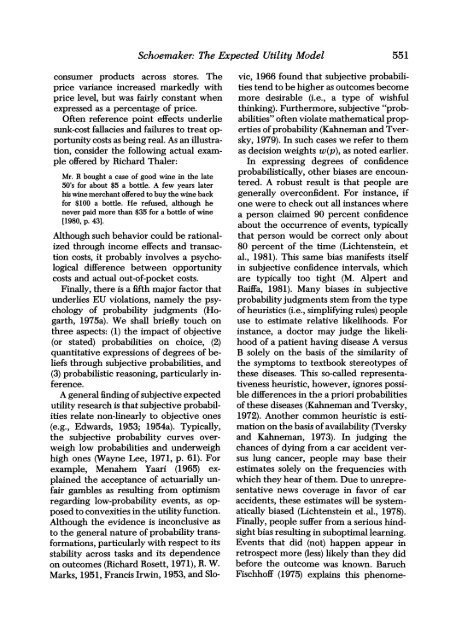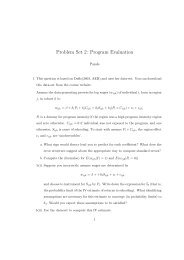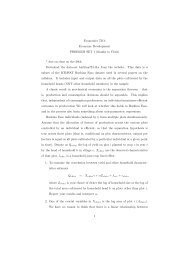The Expected Utility Model: Its Variants, Purposes, Evidence and ...
The Expected Utility Model: Its Variants, Purposes, Evidence and ...
The Expected Utility Model: Its Variants, Purposes, Evidence and ...
You also want an ePaper? Increase the reach of your titles
YUMPU automatically turns print PDFs into web optimized ePapers that Google loves.
Schoemaker: <strong>The</strong> <strong>Expected</strong> <strong>Utility</strong> <strong>Model</strong> 551<br />
consumer products across stores. <strong>The</strong><br />
price variance increased markedly with<br />
price level, but was fairly constant when<br />
expressed as a percentage of price.<br />
Often reference point effects underlie<br />
sunk-cost fallacies <strong>and</strong> failures to treat opportunity<br />
costs as being real. As an illustration,<br />
consider the following actual example<br />
offered by Richard Thaler:<br />
Mr. R bought a case of good wine in the late<br />
50's for about $5 a bottle. A few years later<br />
his wine merchant offered to buy the wine back<br />
for $100 a bottle. He refused, although he<br />
never paid more than $35 for a bottle of wine<br />
[1980, p. 431.<br />
Although such behavior could be rationalized<br />
through income effects <strong>and</strong> transaction<br />
costs, it probably involves a psychological<br />
difference between opportunity<br />
costs <strong>and</strong> actual out-of-pocket costs.<br />
Finally, there is a fifth major factor that<br />
underlies EU violations, namely the psychology<br />
of probability judgments (Hogarth,<br />
1975a). We shall briefly touch on<br />
three aspects: (1)the impact of objective<br />
(or stated) probabilities on choice, (2)<br />
quantitative expressions of degrees of beliefs<br />
through subjective probabilities, <strong>and</strong><br />
(3)probabilistic reasoning, particularly inference.<br />
A general finding of subjective expected<br />
utility research is that subjective probabilities<br />
relate non-linearly to objective ones<br />
(e.g., Edwards, 1953; 1954a). Typically,<br />
the subjective probability curves overweigh<br />
low probabilities <strong>and</strong> underweigh<br />
high ones (Wayne Lee, 1971, p. 61). For<br />
example, Menahem Yaari (1965) explained<br />
the acceptance of actuarially unfair<br />
gambles as resulting from optimism<br />
regarding low-probability events, as opposed<br />
to convexities in the utility function.<br />
Although the evidence is inconclusive as<br />
to the general nature of probability transformations,<br />
particularly with respect to its<br />
stability across tasks <strong>and</strong> its dependence<br />
on outcomes (Richard Rosett, 1971), R. W.<br />
Marks, 1951, Francis Irwin, 1953, <strong>and</strong> Slo-<br />
vic, 1966 found that subjective probabilities<br />
tend to be higher as outcomes become<br />
more desirable (i.e., a type of wishful<br />
thinking). Furthermore, subjective "probabilities"<br />
often violate mathematical properties<br />
of probability (Kahneman <strong>and</strong> Tversky,<br />
1979). In such cases we refer to them<br />
as decision weights w(p),as noted earlier.<br />
In expressing degrees of confidence<br />
probabilistically, other biases are encountered.<br />
A robust result is that people are<br />
generally overconfident. For instance, if<br />
one were to check out all instances where<br />
a person claimed 90 percent confidence<br />
about the occurrence of events, typically<br />
that person would be correct only about<br />
80 percent of the time (Lichtenstein, et<br />
al., 1981). This same bias manifests itself<br />
in subjective confidence intervals, which<br />
are typically too tight (M. Alpert <strong>and</strong><br />
RaifFa, 1981). Many biases in subjective<br />
probability judgments stem from the type<br />
of heuristics (i.e., simplifying rules) people<br />
use to estimate relative likelihoods. For<br />
instance, a doctor may judge the likelihood<br />
of a patient having disease A versus<br />
B solely on the basis of the similarity of<br />
the symptoms to textbook stereotypes of<br />
these diseases. This so-called representativeness<br />
heuristic, however, ignores possible<br />
differences in the a priori probabilities<br />
of these diseases (Kahneman <strong>and</strong> Tversky,<br />
1972). Another common heuristic is estimation<br />
on the basis of availability (Tversky<br />
<strong>and</strong> Kahneman, 1973). In judging the<br />
chances of dying from a car accident versus<br />
lung cancer, people may base their<br />
estimates solely on the frequencies with<br />
which they hear of them. Due to unrepresentative<br />
news coverage in favor of car<br />
accidents, these estimates will be systematically<br />
biased (Lichtenstein et al., 1978).<br />
Finally, people suffer from a serious hindsight<br />
bias resulting in suboptimal learning.<br />
Events that did (not) happen appear in<br />
retrospect more (less) likely than they did<br />
before the outcome was known. Baruch<br />
Fischhoff (1975) explains this phenome-




